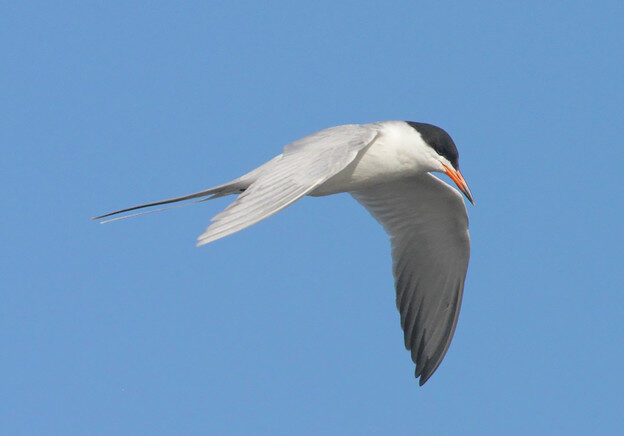Forster’s Tern, Sterna forsteri
Bill Rowe
If you find yourself around a large lake or river, spring through fall, you have a chance of seeing some terns. These are close relatives of gulls, but more elegant and (to some) more appealing, with their long, pointed wings and buoyant flight. Of our five regular species, Forster’s Tern is typical and a good starting point for learning this group. It breeds in marshy wetlands of the northern Great Plains, the mountain West, and the Atlantic and Gulf coasts, and thus entirely within North America, and it winters along the coasts of the southern U.S., the Caribbean, and Middle America. Like other birds, it divides its time between resting—on buoys, piers, logs, and sandbars—and feeding, by coursing back and forth over the water surface and then plunging down to seize the small fish that make up most of its diet. It’s typical to see Forster’s Terns in small flocks of a few or a dozen, often mixed in with other gulls and terns (collectively called “larids”).
IDENTIFICATION: As adults, Forster’s Terns change their appearance twice a year; they molt from breeding plumage (April-August) to non-breeding (the rest of the year) and back again. Now, in September, they are in non-breeding plumage, in which they are easy to identify by their white head with a large black eye-patch, a pattern shown by no other species (see photo above). The bill is black, and the upper surface of the wing is entirely pale gray to silvery-white on the primaries, another unique feature. Come spring, in breeding plumage, they acquire a full black cap, and the bill becomes orange-red at the base (see left photo below). At that time they are easy to confuse with another species, the Common Tern; see your field guide.
ST. LOUIS STATUS: A common migrant spring and fall at places like Riverlands or Creve Coeur Lake (in Missouri) or Carlyle or Horseshoe Lakes (in Illinois). Even in midsummer, some Forster’s Terns may show up unpredictably, and, as the hardiest tern, they may occasionally linger into November.
Learn more and listen to the harsh calls of Forster’s Tern here.




